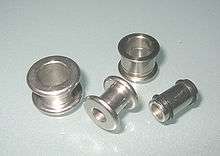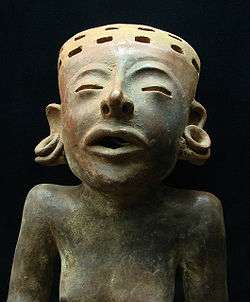Flesh tunnel

A flesh tunnel is a hollow, tube-shaped variety of body piercing jewellery. It is also sometimes referred to as a spool, fleshy, earlet, expander, or eyelet.
A flesh tunnel is usually used in stretched or scalpelled piercings. Flesh tunnels are made in smaller gauges. However, the smaller the gauge the smaller the effect to see through the plug becomes. A person may choose to wear flesh tunnels instead of flesh plugs because they weigh less; at higher gauges, the weight difference increases. Flesh tunnels may be worn with a captive bead ring or other object passed through them.
Flesh tunnels are fashioned from a broad range of materials, including surgical steel, titanium, Pyrex glass, silicone, acrylic glass, bone, horn, amber, bamboo, stone, and wood. Flesh tunnels, like flesh plugs, may feature a decorative inlay or semi-precious stones. Some flesh tunnels have flares to keep the jewellery from falling out. If there are no flares, grooves may be cut near the edges to allow rubber or silicone o-rings to hold the jewellery in place. The back of the flesh tunnel may also screw off. A flesh tunnel may also have an internally threaded backing, as externally threaded pieces can rip freshly stretched ears.
Although flesh tunnels are often worn in the earlobe, other soft-tissue piercings (such as in the nasal septum or nipples) can be fitted with one of an appropriate length.
Origin
The Harappan, Burmese and various peoples of Africa and the Americas (such as the Totonac people) designed, fabricated, and wore flesh tunnels before Western subcultures adopted this type of jewellery. In the New Kingdom of Egypt, earplugs and tunnels were among the jewellery available to both men and women.
 A Totonac statuette
A Totonac statuette
| Wikimedia Commons has media related to Flesh tunnels. |